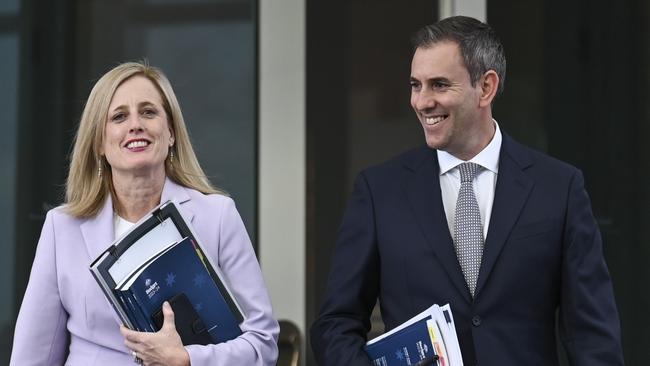$22.1bn in black, another budget surplus looming for Jim Chalmers
`Persistently high commodity prices and a soft economic landing could deliver back-to-back budget surpluses.

Persistently high commodity prices and a soft economic landing could deliver back-to-back budget surpluses, after the nation rode a wave of “war and inflation” to push the federal government’s finances $22.1bn into the black in the last financial year.
Department of Finance figures to be released on Friday will reveal a $100bn fiscal turnaround since the pre-election budget update in April last year – the largest-ever improvement in dollar terms.
Days after S&P Global Ratings reaffirmed Australia’s coveted AAA debt rating, Jim Chalmers said the government had “delivered this surplus at the same time as providing billions of dollars in cost-of-living relief and making vital investments in the long-term growth of our economy”.
“By banking most of the revenue upgrade when inflation was at its peak, our budget strategy has been exactly right for the times and suited to the challenges we confront,” Dr Chalmers said.
Treasury calculates the government saved 95 per cent of the huge upgrades to the tax take since the pre-election economic and fiscal outlook.
Lower deficits have allowed the federal government to borrow $87.2bn less than anticipated by mid-2023, saving taxpayers $12bn in interest charges over the five years to 2026-27, according to Treasury estimates.
As the Treasurer claimed credit for the first surplus since Peter Costello’s final budget, delivered in 2007, independent economist Chris Richardson said a $157bn improvement in the federal government’s bottom line over the four years to 2025-26 had happened “despite our politicians, not because of them”.
Mr Richardson said policy decisions made since the election have worsened the budget bottom line by $34bn, with $61bn in new spending initiatives only partially offset by tax-raising measures worth $27bn.
“So the budget got better mostly because it was never as bad as Treasury projected it to be,” he said.
The May budget forecast a $13.9bn deficit in 2023-24 but, with the iron ore price defying gravity and the economy poised to avoid a recession, economists believe the nation’s finances could remain in the black for a second straight year.
Crucially, Treasury assumed the iron ore price would steadily decline from an average of $US117/tonne in the March quarter, to $US60/t a year later.
Instead, the price of Australia’s key export commodity remains around $US120/t, which Mr Richardson suggested provides “a real chance of a surplus this year too, although it’s far from a done deal”.
“If the economic landing stays soft and commodities stay strong, then that combination is a good one,” Mr Richardson said.
Westpac in early August predicted an $11bn surplus for 2023-24, and the Finance Department on Friday will also release statements for the months of July and August.
Contrasting the latest budget estimates with the 2022 pre-election economic and fiscal outlook (PEFO), Mr Richardson said Treasury officials had vastly underestimated the fiscal tailwinds from “war and inflation”.
As commodity prices boomed and an overstimulated economy sent unemployment to near 50-year lows, the forecast tax take over the four years was $273bn higher than predicted in the PEFO just over a year earlier.
The trends that delivered a tax windfall also drove an unforeseen $82bn lift in costs, most notably in major spending areas such as the NDIS.
“None of the huge shifts noted above were due to any decision by the government,” Mr Richardson said.
“The budget came good despite our politicians, not because of them.”
The May budget predicts that after the quick return to the black after 15 years, the budget will plunge back into deficits out to the early 2030s, as spending surges higher on the NDIS, health, aged care, defence and interest.
“Meantime, the government has adopted very weak rules for the budget – essentially promising not to spend all of the windfalls it receives,” Mr Richardson said.
“But China’s slowdown says the next decade will see budget tailwinds turn into headwinds, meaning the great ‘age of budgetary windfalls’ is fast coming to an end. To date, Australia doesn’t have a plan – or rules in place – to handle that,” he said.








To join the conversation, please log in. Don't have an account? Register
Join the conversation, you are commenting as Logout